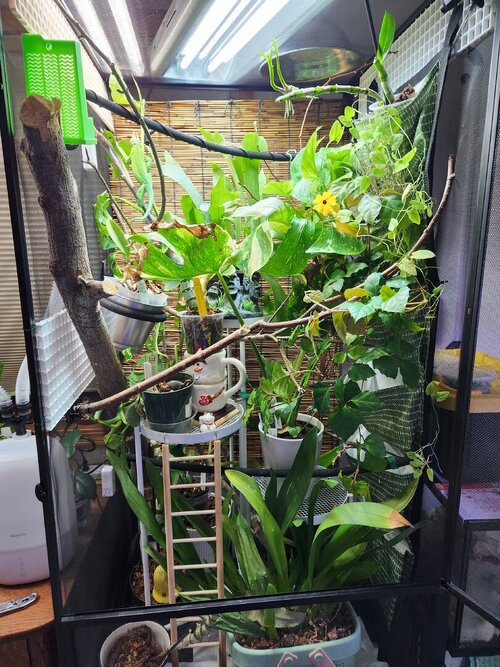USSTrioceros
Member
My Jackson, Phineas, hurt his tongue. Not sure if it was over extended, bludgeoned while feeding, or what. He's been to the vet already for the inital look over and a secondary trip to retrieve a swallowed tongue. I just got him to eat a small hornworm for the first time in 5 days. I am so relieved.
I'm hoping for some feedback, bonus if someone has dealt with this. Obviously, his tongue is inflamed and bright red. That is expected. I noticed tonight it seemed like the globby, sticky part folds up to the roof of the mouth. It makes it hard for him to eat because it's in the way. Also, I had to fight him a bit to get the tip of his tongue back in his mouth. I've looked at diagrams but wonder if that sticky part is supposed to slide back over the bone, too. Is there a spot where it's suppsed to rest in the mouth? Maybe I'm not finding a good diagram.
Secondly, how long should I expect (approximately) to see improvement in the tongue. I'm estimating 2-3 weeks of careful feeding. For anyone who's had a cham with this problem, what improvement did you see first? Tongue color change, less inflammation, improved activity levels, etc.? Obviously I want him 100% by morning but this was a pretty bad injury. What about signs it's getting worse?
Third, do silkworms have the biting potential hornworms do? I want to get some for him as soon as weather permits. I'll be feeding him squishy things for a bit. I'll keep an eye out for fresh bug molts, too. He's not a fan of soldier fly larvae.
Lastly, if anyone is in Western Montana, do you know a veterinarian versed in Chameleons? I'm in Missoula. Our doc here is great but she's a bit more tuned to snakes, geckos, and bearded dragons. I'm grateful for her, though. If she's not available for some reason, I want another name or two. I am approximately 2-3 hours from Kalispell, Great Falls, and Bozeman in MT. Same for Spokane, WA.
Thanks in advance. Other advice is welcome.
Care info: 2x2x4, UVB T5 5.0, LED grow lights, ceramic heat emitter (until I can find a consistent source for incandescent heat lamps) misting morning and night, humidifier 12-6am, humidity levels kinda suck and will be adding side panels; ambient temps 70-73F, basking 80-82F, highest branch is 5-6in from UVB and levels usually read about 90-95uW/cm² (older solarmeter); gobs of plants, gobs of chameleon highways and hidey spots. The only iffy thing I have at the moment is a cat water fountain to make water more accessible during healing. He drinks from it but he's more of a drip drinker.
I'm hoping for some feedback, bonus if someone has dealt with this. Obviously, his tongue is inflamed and bright red. That is expected. I noticed tonight it seemed like the globby, sticky part folds up to the roof of the mouth. It makes it hard for him to eat because it's in the way. Also, I had to fight him a bit to get the tip of his tongue back in his mouth. I've looked at diagrams but wonder if that sticky part is supposed to slide back over the bone, too. Is there a spot where it's suppsed to rest in the mouth? Maybe I'm not finding a good diagram.
Secondly, how long should I expect (approximately) to see improvement in the tongue. I'm estimating 2-3 weeks of careful feeding. For anyone who's had a cham with this problem, what improvement did you see first? Tongue color change, less inflammation, improved activity levels, etc.? Obviously I want him 100% by morning but this was a pretty bad injury. What about signs it's getting worse?
Third, do silkworms have the biting potential hornworms do? I want to get some for him as soon as weather permits. I'll be feeding him squishy things for a bit. I'll keep an eye out for fresh bug molts, too. He's not a fan of soldier fly larvae.
Lastly, if anyone is in Western Montana, do you know a veterinarian versed in Chameleons? I'm in Missoula. Our doc here is great but she's a bit more tuned to snakes, geckos, and bearded dragons. I'm grateful for her, though. If she's not available for some reason, I want another name or two. I am approximately 2-3 hours from Kalispell, Great Falls, and Bozeman in MT. Same for Spokane, WA.
Thanks in advance. Other advice is welcome.
Care info: 2x2x4, UVB T5 5.0, LED grow lights, ceramic heat emitter (until I can find a consistent source for incandescent heat lamps) misting morning and night, humidifier 12-6am, humidity levels kinda suck and will be adding side panels; ambient temps 70-73F, basking 80-82F, highest branch is 5-6in from UVB and levels usually read about 90-95uW/cm² (older solarmeter); gobs of plants, gobs of chameleon highways and hidey spots. The only iffy thing I have at the moment is a cat water fountain to make water more accessible during healing. He drinks from it but he's more of a drip drinker.










